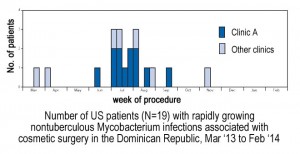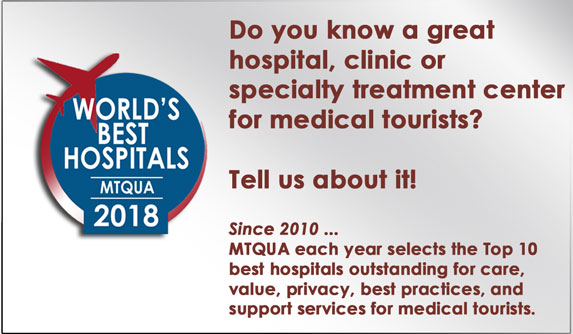
Woman describes her surgery in Dominican Republic and subsequent treatment for antibiotic resistant infection.
To blacklist: to boycott, to avoid, to steer clear of.
When significant numbers of rehospitalizations and deaths among medical tourists occur in one location – as in the current case of the Dominican Republic – the harsh facts of risks that medical tourists face cannot be brushed aside.
Since there is no structured way to report or gather information about medical tourist outcomes, the most reliable and often the only information about outcomes – both good and bad – comes from newspaper and online reports of individual cases. Sometimes, as in the case of medical tourists who traveled to the Dominican Republic for surgery, the bad outcomes may indicate serious problems at the medical destination that should not be treated lightly or ignored.
After losing more than 100 pounds, Beverly Brignoni, a 29-year-old New York woman, traveled to Santo Domingo, Dominican Republic for a tummy tuck. Upon the recommendation of friends, she arranged her surgery at the Vista del Jardin Medical Center by Dr. Guillermo Lorenzo. Beverly Brignoni died on the operating table. Read the New York Daily News article.
Medical tourists get serious infections after surgery in Dominican Republic
Beverly Brignoni is the latest tragedy the medical tourism industry should not forget.[Tweet “Beverly Brignoni a medical tourism tragedy.”]
Currently, the U.S. Centers for Disease Control is tracking cases of highly antibiotic resistant infections among medical tourists traveling to the Dominican Republic for cosmetic surgery. The CDC is following at least 19 medical tourists who had plastic surgery in clinics in the Dominican Republic in the past 18 months.
The cases came to light after the patients, upon returning to their homes in America, experienced symptoms including abdominal abscess, pain, fever and wound discharge and went to local doctors for treatment. Most of the women were found to have nontuberculous mycobacterial (RG-NTM) surgical-site infections.
Two women sought care locally and their cases were reported to the Maryland Department of Health and Mental Hygiene in August 2013. Additional cases have since been identified in Connecticut, Massachusetts, New York and Pennsylvania.
The CDC reports that both patients had undergone surgical procedures as medical tourists at the same private surgical clinic (“Clinic A”) in the Dominican Republic a month earlier. Within 7 days of returning home, both sought care for symptoms that included surgical wound abscesses, clear fluid drainage, pain, and fever. Initial antibiotic therapy was ineffective.[Tweet “Should Dominican Republic be first blacklisted medical tourism country?”]
8 Dominican Republic clinics are identified
This is not a situation where only one clinic or one doctor is at fault.
Of the 19 patients tracked to date, 12 reported undergoing surgery at the same clinic in Santo Domingo, the capital of the Dominican Republic. 9 of them were attended by the same surgeon. The other 7 reported having surgery at 7 different clinics also in the Dominican Republic. All patients were women between 18 and 50 years old. 
Most of the women had liposuction done, and some also had abdominoplasties or breast augmentations. Symptoms of infection developed after they returned to the United States; several patients consulted with plastic surgeons after their return. The surgeons notified their state and local health departments.
14 women were hospitalized in the U.S. and required multiple therapeutic and corrective surgical procedures and prolonged antibiotic therapy; 5 were treated as outpatients. No deaths were reported.
State and local health departments have issued a national advisory. The advisory is aimed at all plastic surgery; dermatology; primary care; family, emergency and internal medicine; general surgery; infectious disease; laboratory medicine and infection control staff. The CDC is concerned that additional infected patients have not yet been reported.
CDC notified public health authorities in the Dominican Republic of the outbreak investigation and recommended patient follow-up and onsite assessment of infection control practices at the implicated clinics. Clinic A has reportedly been closed temporarily by Dominican authorities.[Tweet “CDC urges closure of Dominican Republic plastic surgery clinic.”]
Health care associated infections can lead to death
Health care-associated infections (HAI) are a threat to patient safety. Every day, patients get infections in health care facilities while they are being treated for something else. These infections can have devastating emotional, financial, and medical effects.
Worst of all, they can be deadly.
Leigh Turner, professor in the Center Of Bioethics at the University of Minnesota, has gathered reports of cases in which medical tourists died during or after surgery. Of the 26 cases he identified through published reports, 11 individuals died after surgery in Mexico, and 4 after surgery in the Dominican Republic. He found that deaths of medical tourists also occurred in Hungary (2 deaths), Brazil, Colombia, Cyprus, Dubai, India, Malaysia, Panama, Spain, and the U.S. (1 death each).
Beverly Brignoni brings the Dominican Republic count to at least 5 medical tourists dead.
Is it time for a medical tourism blacklist?
Given so many incidents of infection and death in the Dominican Republic, should the Dominican Republic become the first “blacklisted” medical destination?
Information for this article came from CDC reports, the American Medical Association and the American Society of Plastic Surgeons.

 >
>
2 Responses to Is There A Medical Tourism Blacklist?